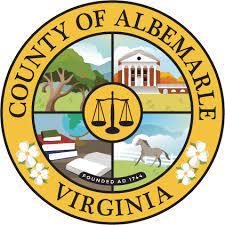At their meeting on January 17, 2024, the Albemarle Board of Supervisors reviewed draft goals and objectives for five of the eight chapters in the update of the Comprehensive Plan. The process is called AC44.
“AC44 is organized into four phases,” said Tori Kanellopoulos, a principal planner for the county. “In the first phase we developed the AC44 Framework for an Equitable and Resilient Community.”

This first phase also included taking a look at the county’s designated growth areas to see if there is enough land in the development area to provide for thousands more residential units. This build-out analysis was completed in September 2022. (view the document)
The second phase has involved development of what the county refers to as “toolkits” to help think through how Albemarle should consider expansion of the development area or allow more uses in some parts of the rural area.
“We asked for the Board’s direction on these toolkits and we heard that we should find ways to encourage more density and mixed-use development in the development areas and prioritize using development area land efficiently over expansion,” Kanellopoulos said.
Supervisors also gave direction to provide health services and community centers in the rural area.
Some of the names of chapters have been changed.
“Environmental Stewardship is the new name for the Natural Resources chapter and there are separate Rural Area and Development Areas chapters,” Kanellopoulos said. “But they each have the Land Use and Transportation elements combined so there’s not a stand-alone transportation chapter.
Kanellopoulos said revisions will be made after feedback from the Board, feedback that followed engagement with the Planning Commission and other bodies.
Phase three will begin later in the spring with specific action steps for each chapter of the plan. Phase four will be the creation of a single Comprehensive Plan with public hearings before Supervisors and the Planning Commission.
Here’s a link to a summary of feedback from the Planning Commission.
Supervisors on Environmental Stewardship goals and objectives
The first chapter is one renamed during the AC44 process and has the goals of Climate Action, Climate Resilience, Healthy and Resilient Waterways and Water Supplies, Biodiversity and Habitats, and Sustainable Materials Management. (view the draft goals and objectives)
Goal 1 relates to efforts to meet ambitious goals for climate action.
“Goal 1. Albemarle County will undertake robust local climate action by implementing the County’s Climate Action Plan (2020) and future updates to meet the Board of Supervisors’ targets to reduce community greenhouse gas emissions by 45 percent from 2008 levels by 2030, achieve zero net emissions by 2050, and bring multiple benefits to the community and environment.”
There are then four objectives. Supervisor Bea LaPisto-Kirtley had a suggestion.
“When we talk about Goal One, what rose to my mind is maybe asking our developers to use solar roof panels on developments,” LaPisto-Kirtley said. “I don’t know if that’s feasible or not but maybe. I don’t know it could be required or suggested.”
LaPisto-Kirtley also suggested language to push Albemarle to build solar roofs on its facilities and to use reflective paint in surface parking lots to reduce the heat island effect.
Supervisor Ned Gallaway said he appreciated a specific metric in objective 1.1 to reduce transportation emissions by at least 37 percent by encouraging walking, cycling, transit, telecommuting, and transitioning to electric vehicles.
“Walking, cycling, and transit,” Gallaway said. “I can see why those three would be lumped together. In my mind as a Supervisor, that goes to our [Capital Improvement Program] and are we providing the infrastructure to be able to increase the use of walking, cycling and transit. So it leads me to pragmatic standpoints of are we going to put the infrastructure in place to be able to increase the use of this? Are those going to show up in the action steps? Or is this just going to be educating the public that you should walk more?”
Gallaway said he is concerned about making government decisions that will force people to change their behavior. He also said the county was limited in its ability to provide transit given that Albemarle does not have a vote in how Charlottesville Area Transit is run.
Supervisor Ann Mallek agreed with a suggestion from the Planning Commission that language about limiting light pollution needs to be present in what had been called the natural resources chapter.
“The Dark Skies needs to be an Environmental Stewardship issue as well as a scenic issue as well as an economic development issue because there are communities in Texas and New Mexico and Nelson County who are now welcoming visitors who want to be able to see the stars,” Mallek said.
Mallek also made a pitch for Goal 4, which calls for the implementation of Albemarle’s Biodiversity Action Plan.
“It has not been well respected in our decision making and it needs to be in the checklist of things that are regularly considered,” Mallek said.
Mallek also raised caution about losing forests to solar fields, suggested requiring tree conservation plans as part of developments, and reminded Supervisors that one reason to preserve land is that so food can be grown.
“If we can figure out a way to recognize soil for food production I think that will be a good thing for our Comprehensive Plan,” Mallek said.
Supervisor Michael Pruitt supported Malleks’ point on Dark Skies and added he thought the draft goals and objectives needed to have language about equity.
“When you look at my district, the people who are paying disproportionately more for their utility costs, the people who are experiencing higher heat indexes, people who have less tree canopy are people who are living in neighborhoods that are currently and or historically more racially diverse and more impoverished,” Pruitt said. “That seems like it bears explicit lampshading and highlighting in our plan and how we think about addressing issues of environmental quality.”
Pruitt also wanted more acknowledgment of how the county can help individuals who are affected by climate change.
Supervisor Diantha McKeel echoed support for dark skies but said the county needed cooperation from other institutions.
“It seems like to me with dark skies, we’re not going to accomplish dark skies in this community unless we have [the University of Virginia] and the city at the table with us,” McKeel said.
McKeel suggested that the Land Use and Environmental Planning Committee take up the issue, referring to a closed-door group of planners from all three entities and the Rivanna Water and Sewer Authority that meet once a month on planning issues. The meetings are not open to the public but agendas and minutes are posted online.

McKeel also called for the ability to expand public water and sewer to rural area properties off of Hydraulic Road in her district to address failing septic systems.
“I’m not talking about an expansion of the development area,” McKeel said. “I’m talking about trying to figure out how to deal with failing septic systems that are 60 years old that sometimes have people see sewage bubbling up. I actually have constituents that don’t even know they have a septic system.”
Supervisor Gallaway also wanted to have a better sense of what is expected of particular words.
“When I see things like ‘protect’ and ‘support’ and ‘increase’ and whatever the verbs are that we’re going to use, then the how are we doing to do what becomes important,” Gallaway said. It’s great if its aspirational! That means we don’t have to pay for it. But if it’s achievable, then the Comp Plan is supposed to say ‘here’s now the back up of how we’re going to get in to the doing of these things.’”
For this next one, let’s hear Goal 4.
“Goal 4: Albemarle County will achieve better local biological diversity, ecological integrity, and ecosystem resilience, including by implementing the Biodiversity Action Plan.”
Gallaway has critique of the language in objective 4.5.
“When I see objectives like ‘increase native plant species on County-owned properties,’” Gallaway said. “Bam! Clean. We’ve got control of our property. It’s doable. Let’s get at it. But not it seems like we throw a tag on this objective. ‘And support adoption of these actions on private land.’ Is that just a high five? Let’s say to our community that the county is specifically stating that we’re going to do this on our land. And then if we think it’s important to encourage or support or whatever the word is on private land then that should probably be set up under a different category in my opinion or maybe it gets worked out in the action steps again.”
At this work session, Supervisors also went through goals and objectives of the Parks and Recreation chapter, the Historic, Scenic, and Cultural Resources chapter, the Housing chapter, and the Economic Development chapter. I’ll eventually circle back to those as I try to broaden my coverage of AC44 in 2024.
Before you go: The time to write and research of this article is covered by paid subscribers to Charlottesville Community Engagement. In fact, this particular installment comes from the January 26, 2024 edition of the newsletter and podcast. To ensure this research can be sustained, please consider becoming a paid subscriber or contributing monthly through Patreon.














